Research Progress in Fluid Energy Collection Based on Friction Nanogenerators
Abstract
:1. Introduction
2. Recent Developments in Triboelectric Nanogenerator-Based Fluid Energy Harvesting Systems
2.1. Wind Energy Collection
2.1.1. Rotating Structure AC Output Device
2.1.2. Rotary Structure DC Output Device
2.1.3. Rotating Self-Adjusting Structure Output Device
2.1.4. Energy Harvesting Device Based on Flutter Structure

| TENG | Operating Wind Speed Range | Short-Circuit Current | Open-Circuit Voltage | Power/Power Density | Ref. |
|---|---|---|---|---|---|
| PTFE-based flexible wind-driven TENG | [41] | ||||
| WBF-TENG | [42] | ||||
| LL-TENG | [43] | ||||
| WG-TENG | 1~8.1 m/s | [44] | |||
| W-TENG structure after adding channels | [45] | ||||
| Self-suspended shell-based triboelectric nanogenerator | [46] | ||||
| C-TENG | [47] | ||||
| C-TENG and CIA-TENG | [48] | ||||
| Tree-structured triboelectric nanogenerator | [49] |
2.2. Wave-Based Energy Harvesting Device
2.2.1. Cylindrical Structure AC Output Device
2.2.2. Cylindrical DC Output Device
2.2.3. Pendulum Structure Energy Harvesting Device
2.2.4. Bionic Structure Energy Harvesting Device
3. Optimization of Fluid Energy Harvesting Devices
3.1. Material and Structural Optimization
3.2. Expending Hybrid Energy Harvesting Device
3.3. Development of High-Power TENG
4. Summary and Outlook
Author Contributions
Funding
Data Availability Statement
Conflicts of Interest
References
- Kembleton, R. Technological features of a commercial fusion power plant, and the gap from DEMO. Fusion Eng. Des. 2023, 190, 113544. [Google Scholar] [CrossRef]
- Stoppato, A.; Mirandola, A.; Meneghetti, G.; Lo Casto, E. On the operation strategy of steam power plants working at variable load: Technical and economic issues. Energy 2012, 37, 228–236. [Google Scholar] [CrossRef]
- Yu, Y.; Zhou, P.; Men, W. Impact of long-term operation of nuclear power plants on the marine ecosystem of Daya Bay. Mar. Pollut. Bull. 2023, 193, 115146. [Google Scholar] [CrossRef] [PubMed]
- Zhang, M.; Duan, Z.; Zhang, B.; Yuan, Z.; Zhao, Q.; Jiang, Y.; Tai, H. Electrochemical humidity sensor enabled self-powered wireless humidity detection system. Nano Energy 2023, 115, 108745. [Google Scholar] [CrossRef]
- Li, S.; Ma, T.; Wang, D. Photovoltaic pavement and solar road: A review and perspectives. Sustain. Energy Technol. Assess. 2023, 55, 102933. [Google Scholar] [CrossRef]
- Parida, B.; Iniyan, S.; Goic, R. A review of solar photovoltaic technologies. Renew. Sustain. Energy Rev. 2011, 15, 1625–1636. [Google Scholar] [CrossRef]
- Leon, M., Jr. Recycling of wind turbine blades: Recent developments. Curr. Opin. Green Sustain. Chem. 2023, 39, 100746. [Google Scholar] [CrossRef]
- Liu, Z.; Chen, Y.; Yang, X.; Yan, J. Power to heat: Opportunity of flexibility services provided by building energy systems. Adv. Appl. Energy 2023, 11, 100149. [Google Scholar] [CrossRef]
- Champier, D. Thermoelectric generators: A review of applications. Energy Convers. Manag. 2017, 140, 167–181. [Google Scholar] [CrossRef]
- Fan, F.-R.; Tian, Z.-Q.; Lin Wang, Z. Flexible triboelectric generator. Nano Energy 2012, 1, 328–334. [Google Scholar] [CrossRef]
- Dharmasena, R.D.I.G.; Jayawardena, K.D.G.I.; Mills, C.A.; Dorey, R.A.; Silva, S.R.P. A unified theoretical model for Triboelectric Nanogenerators. Nano Energy 2018, 48, 391–400. [Google Scholar] [CrossRef]
- Wang, Z.L. On Maxwell’s displacement current for energy and sensors: The origin of nanogenerators. Mater. Today 2017, 20, 74–82. [Google Scholar] [CrossRef]
- Zou, H.; Zhang, Y.; Guo, L.; Wang, P.; He, X.; Dai, G.; Zheng, H.; Chen, C.; Wang, A.C.; Xu, C.; et al. Quantifying the triboelectric series. Nat. Commun. 2019, 10, 1427. [Google Scholar] [CrossRef] [PubMed]
- Liu, D.; Zhou, L.; Cui, S.; Gao, Y.; Li, S.; Zhao, Z.; Yi, Z.; Zou, H.; Fan, Y.; Wang, J.; et al. Standardized measurement of dielectric materials’ intrinsic triboelectric charge density through the suppression of air breakdown. Nat. Commun. 2022, 13, 6019. [Google Scholar] [CrossRef] [PubMed]
- Zhang, H.; Liu, F.; Phanikumar, M.S.; Meerschaert, M.M. A novel numerical method for the time variable fractional order mobile–immobile advection–dispersion model. Comput. Math. Appl. 2013, 66, 693–701. [Google Scholar] [CrossRef]
- Dai, N.; Lei, I.M.; Li, Z.; Li, Y.; Fang, P.; Zhong, J. Recent advances in wearable electromechanical sensors—Moving towards machine learning-assisted wearable sensing systems. Nano Energy 2023, 105, 108041. [Google Scholar] [CrossRef]
- Zhu, G.; Pan, C.; Guo, W.; Chen, C.-Y.; Zhou, Y.; Yu, R.; Wang, Z.L. Triboelectric-Generator-Driven Pulse Electrodeposition for Micropatterning. Nano Lett. 2012, 12, 4960–4965. [Google Scholar] [CrossRef]
- Jiang, D.; Lian, M.; Xu, M.; Sun, Q.; Xu, B.B.; Thabet, H.K.; El-Bahy, S.M.; Ibrahim, M.M.; Huang, M.; Guo, Z. Advances in triboelectric nanogenerator technology—Applications in self-powered sensors, Internet of things, biomedicine, and blue energy. Adv. Compos. Hybrid Mater. 2023, 6, 57. [Google Scholar] [CrossRef]
- Chu, H.; Jang, H.; Lee, Y.; Chae, Y.; Ahn, J.-H. Conformal, graphene-based triboelectric nanogenerator for self-powered wearable electronics. Nano Energy 2016, 27, 298–305. [Google Scholar] [CrossRef]
- Shao, J.; Jiang, T.; Wang, Z. Theoretical foundations of triboelectric nanogenerators (TENGs). Sci. China Technol. Sci. 2020, 63, 1087–1109. [Google Scholar] [CrossRef]
- Ghorani, M.M.; Karimi, B.; Mirghavami, S.M.; Saboohi, Z. A numerical study on the feasibility of electricity production using an optimized wind delivery system (Invelox) integrated with a Horizontal axis wind turbine (HAWT). Energy 2023, 268, 126643. [Google Scholar] [CrossRef]
- Zabarjad Shiraz, M.; Dilimulati, A.; Paraschivoiu, M. Wind power potential assessment of roof mounted wind turbines in cities. Sustain. Cities Soc. 2020, 53, 101905. [Google Scholar] [CrossRef]
- Dar, A.S.; Armengol Barcos, G.; Porté-Agel, F. An experimental investigation of a roof-mounted horizontal-axis wind turbine in an idealized urban environment. Renew. Energy 2022, 193, 1049–1061. [Google Scholar] [CrossRef]
- Volkmer, K.; Kaufmann, N.; Carolus, T.H. Mitigation of the aerodynamic noise of small axial wind turbines—Methods and experimental validation. J. Sound Vib. 2021, 500, 116027. [Google Scholar] [CrossRef]
- Karasmanaki, E. Is it safe to live near wind turbines? Reviewing the impacts of wind turbine noise. Energy Sustain. Dev. 2022, 69, 87–102. [Google Scholar] [CrossRef]
- Cho, S.; Cha, K.; Kim, B.; Lee, J.; Park, K.; Chung, S.-H.; Song, M.; Heo, D.; Son, J.-H.; Choi, M.; et al. Sustainable utilization of aging-deteriorated microplastics as triboelectric nanogenerator. Chem. Eng. J. 2023, 470, 144283. [Google Scholar] [CrossRef]
- Lu, Y.; Qin, Q.; Meng, J.; Mi, Y.; Wang, X.; Cao, X.; Wang, N. Constructing highly flexible dielectric sponge for enhancing triboelectric performance. Chem. Eng. J. 2023, 468, 143802. [Google Scholar] [CrossRef]
- Son, J.-H.; Cha, K.; Chung, S.-H.; Heo, D.; Kim, S.; Choi, M.; Park, I.S.; Hong, J.; Lee, S. Recycled, Contaminated, Crumpled Aluminum Foil-Driven Triboelectric Nanogenerator. Adv. Sci. 2023, 10, 2301609. [Google Scholar] [CrossRef]
- Yar, A.; Okbaz, A.; Parlayıcı, Ş. A biocompatible, eco-friendly, and high-performance triboelectric nanogenerator based on sepiolite, bentonite, and kaolin decorated chitosan composite film. Nano Energy 2023, 110, 108354. [Google Scholar] [CrossRef]
- Möllerström, E.; Gipe, P. The History of Wind Power. In Reference Module in Earth Systems and Environmental Sciences; Elsevier: Amsterdam, The Netherlands, 2023. [Google Scholar]
- Cao, X.; Zhou, H.; Zhou, Y.; Hu, Y.; Wang, Y.; Wang, Z.L.; Sun, Q. High Performance Rotary-Structured Triboelectric-Electromagnetic Hybrid Nanogenerator for Ocean Wind Energy Harvesting. Adv. Mater. Technol. 2023, 8, 2300327. [Google Scholar] [CrossRef]
- Yong, S.; Wang, J.; Yang, L.; Wang, H.; Luo, H.; Liao, R.; Wang, Z.L. Auto-Switching Self-Powered System for Efficient Broad-Band Wind Energy Harvesting Based on Dual-Rotation Shaft Triboelectric Nanogenerator. Adv. Energy Mater. 2021, 11, 202101194. [Google Scholar] [CrossRef]
- Zhao, J.; Mu, J.; Cui, H.; He, W.; Zhang, L.; He, J.; Gao, X.; Li, Z.; Hou, X.; Chou, X. Hybridized Triboelectric-Electromagnetic Nanogenerator for Wind Energy Harvesting to Realize Real-Time Power Supply of Sensor Nodes. Adv. Mater. Technol. 2021, 6, 202001022. [Google Scholar] [CrossRef]
- Tang, X.; Hou, W.; Zheng, Q.; Fang, L.; Zhu, R.; Zheng, L. Self-powered wind sensor based on triboelectric nanogenerator for detecting breeze vibration on electric transmission lines. Nano Energy 2022, 99, 107412. [Google Scholar] [CrossRef]
- Gu, J.; Gong, X.; Lu, T.; Zheng, L.; Li, H. Self-powered wind detection and positioning system for hot air balloon based on multi-module triboelectric nanogenerator. Nano Energy 2023, 116, 108791. [Google Scholar] [CrossRef]
- Cui, J.; Liu, T.; Zheng, Y.; Bai, S.; Li, X.; Xue, C. Optimization of electromagnetic-triboelectric wind energy harvester based on coaxial reversed mechanism with tip discharge. Energy Convers. Manag. 2023, 293, 117456. [Google Scholar] [CrossRef]
- Li, B.; Qiu, Y.; Huang, P.; Tang, W.; Zhang, X. Self-powered forest ambient monitoring microsystem based on wind energy hybrid nanogenerators. Sci. China Technol. Sci. 2022, 65, 2348–2360. [Google Scholar] [CrossRef]
- Zhu, X.; Cao, X.; Wang, Z.L. Windmill-Like Nanogenerator for Harvesting Low-Speed Wind Energy and Wind Speed Measuring. Adv. Mater. Technol. 2022, 7, 2200006. [Google Scholar] [CrossRef]
- Wang, Y.; Li, X.; Yu, X.; Zhu, J.; Shen, P.; Wang, Z.L.; Cheng, T. Driving-torque self-adjusted triboelectric nanogenerator for effective harvesting of random wind energy. Nano Energy 2022, 99, 107389. [Google Scholar] [CrossRef]
- Cho, S.; Lee, D.; Jang, S.; Cho, S.; Shim, J.; Jang, Y.; Lin, Z.-H.; Choi, K.; Choi, D. Physical intelligence-based working mode adaptable triboelectric nanogenerator for effective wind energy harvesting in broad range. Nano Energy 2023, 113, 108608. [Google Scholar] [CrossRef]
- Sun, W.; Wang, N.; Li, J.; Xu, S.; Song, L.; Liu, Y.; Wang, D. Humidity-resistant triboelectric nanogenerator and its applications in wind energy harvesting and self-powered cathodic protection. Electrochim. Acta 2021, 391, 138994. [Google Scholar] [CrossRef]
- Son, J.h.; Heo, D.; Goh, D.; Lee, M.; Chung, J.; Choi, S.; Lee, S. Wind-Driven Bidirectional Fluttering Triboelectric Nanogenerator Via Dual Flagpole and Slot Structure Design. Adv. Mater. Technol. 2022, 8, 2200453. [Google Scholar] [CrossRef]
- Li, H.; Wen, J.; Ou, Z.; Su, E.; Xing, F.; Yang, Y.; Sun, Y.; Wang, Z.L.; Chen, B. Leaf-Like TENGs for Harvesting Gentle Wind Energy at An Air Velocity as Low as 0.2 m s−1. Adv. Funct. Mater. 2023, 33, 2212207. [Google Scholar] [CrossRef]
- Yuan, S.; Zeng, Q.; Tan, D.; Luo, Y.; Zhang, X.; Guo, H.; Wang, X.; Wang, Z.L. Scavenging breeze wind energy (1–8.1 ms−1) by minimalist triboelectric nanogenerator based on the wake galloping phenomenon. Nano Energy 2022, 100, 107465. [Google Scholar] [CrossRef]
- Zhu, W.; Hu, C.; Bowen, C.R.; Wang, Z.L.; Yang, Y. Scavenging low-speed breeze wind energy using a triboelectric nanogenerator installed inside a square variable diameter channel. Nano Energy 2022, 100, 107453. [Google Scholar] [CrossRef]
- Ko, H.-J.; Kwon, D.-S.; Bae, K.; Kim, J. Self-suspended shell-based triboelectric nanogenerator for omnidirectional wind-energy harvesting. Nano Energy 2022, 96, 107062. [Google Scholar] [CrossRef]
- Zhao, C.; Wu, Y.; Dai, X.; Han, J.; Dong, B.; Huang, L.-B. Calliopsis structure-based triboelectric nanogenerator for harvesting wind energy and self-powerd wind speed/direction sensor. Mater. Des. 2022, 221, 111005. [Google Scholar] [CrossRef]
- Shin, Y.; Cho, S.; Han, S.; Jung, G.Y. Omni-directional wind-driven triboelectric nanogenerator with cross-shaped dielectric film. Nano Converg. 2021, 8, 25. [Google Scholar] [CrossRef]
- Bian, Y.; Jiang, T.; Xiao, T.; Gong, W.; Cao, X.; Wang, Z.; Wang, Z.L. Triboelectric Nanogenerator Tree for Harvesting Wind Energy and Illuminating in Subway Tunnel. Adv. Mater. Technol. 2018, 3, 1700317. [Google Scholar] [CrossRef]
- Jiao, P.; Matin Nazar, A.; Egbe, K.-J.I.; Barri, K.; Alavi, A.H. Magnetic capsulate triboelectric nanogenerators. Sci. Rep. 2022, 12, 89. [Google Scholar] [CrossRef]
- Mokarram, M.; Mokarram, M.J.; Najafi, A. Thermal power plants pollution assessment based on deep neural networks, remote sensing, and GIS: A real case study in Iran. Mar. Pollut. Bull. 2023, 192, 115069. [Google Scholar] [CrossRef]
- Peng, Z.; Chen, X.; Yao, L. Research status and future of hydro-related sustainable complementary multi-energy power generation. Sustain. Futures 2021, 3, 100042. [Google Scholar] [CrossRef]
- Prevention of marine corrosion with graphene-based polymer coatings. Focus Powder Coat. 2023, 2023, 4–5. [CrossRef]
- Deng, C.-M.; Xia, D.-H.; Zhang, R.; Behnamian, Y.; Hu, W.; Birbilis, N. On the localized corrosion of AA5083 in a simulated dynamic seawater/air interface—Part 2: Effects of wetting time. Corros. Sci. 2023, 221, 111367. [Google Scholar] [CrossRef]
- Li, P.; Chen, Y.; Huang, H.; Zhang, H.; Xie, H.; Piao, H.-G. Investigation of corrosion behavior of galvanized steel as submarine cable armor in seawater under weak magnetic fields. Int. J. Electrochem. Sci. 2023, 18, 100264. [Google Scholar] [CrossRef]
- Zhang, D.; Shi, J.; Si, Y.; Li, T. Multi-grating triboelectric nanogenerator for harvesting low-frequency ocean wave energy. Nano Energy 2019, 61, 132–140. [Google Scholar] [CrossRef]
- Zhang, S.L.; Xu, M.; Zhang, C.; Wang, Y.-C.; Zou, H.; He, X.; Wang, Z.; Wang, Z.L. Rationally designed sea snake structure based triboelectric nanogenerators for effectively and efficiently harvesting ocean wave energy with minimized water screening effect. Nano Energy 2018, 48, 421–429. [Google Scholar] [CrossRef]
- Cheng, P.; Liu, Y.; Wen, Z.; Shao, H.; Wei, A.; Xie, X.; Chen, C.; Yang, Y.; Peng, M.; Zhuo, Q.; et al. Atmospheric pressure difference driven triboelectric nanogenerator for efficiently harvesting ocean wave energy. Nano Energy 2018, 54, 156–162. [Google Scholar] [CrossRef]
- Li, H.; Liang, C.; Ning, H.; Liu, J.; Zheng, C.; Li, J.; Yao, H.; Peng, Y.; Wan, L.; Liu, G. O-ring-modularized triboelectric nanogenerator for robust blue energy harvesting in all-sea areas. Nano Energy 2022, 103, 107812. [Google Scholar] [CrossRef]
- Hu, Y.; Qiu, H.; Sun, Q.; Wang, Z.L.; Xu, L. Wheel-structured Triboelectric Nanogenerators with Hyperelastic Networking for High-Performance Wave Energy Harvesting. Small Methods 2023, 7, 2300582. [Google Scholar] [CrossRef]
- Han, J.; Liu, Y.; Feng, Y.; Jiang, T.; Wang, Z.L. Achieving a Large Driving Force on Triboelectric Nanogenerator by Wave-Driven Linkage Mechanism for Harvesting Blue Energy toward Marine Environment Monitoring. Adv. Energy Mater. 2022, 13, 2203219. [Google Scholar] [CrossRef]
- Xi, Y.; Guo, H.; Zi, Y.; Li, X.; Wang, J.; Deng, J.; Li, S.; Hu, C.; Cao, X.; Wang, Z.L. Multifunctional TENG for Blue Energy Scavenging and Self-Powered Wind-Speed Sensor. Adv. Energy Mater. 2017, 7, 1602397. [Google Scholar] [CrossRef]
- Jung, H.; Ouro-Koura, H.; Salalila, A.; Salalila, M.; Deng, Z.D. Frequency-multiplied cylindrical triboelectric nanogenerator for harvesting low frequency wave energy to power ocean observation system. Nano Energy 2022, 99, 107365. [Google Scholar] [CrossRef]
- Tan, D.; Zeng, Q.; Wang, X.; Yuan, S.; Luo, Y.; Zhang, X.; Tan, L.; Hu, C.; Liu, G. Anti-Overturning Fully Symmetrical Triboelectric Nanogenerator Based on an Elliptic Cylindrical Structure for All-Weather Blue Energy Harvesting. Nano-Micro Lett. 2022, 14, 124. [Google Scholar] [CrossRef] [PubMed]
- Wang, J.; Zhang, H.; Xie, X.; Gao, M.; Yang, W.; Lin, Y. Water Energy Harvesting and Self-Powered Visible Light Communication Based on Triboelectric Nanogenerator. Energy Technol. 2018, 6, 1929–1934. [Google Scholar] [CrossRef]
- Jung, H.; Friedman, B.; Hwang, W.; Copping, A.; Branch, R.; Deng, Z.D. Self-powered arctic satellite communication system by harvesting wave energy using a triboelectric nanogenerator. Nano Energy 2023, 114, 108633. [Google Scholar] [CrossRef]
- Xu, Q.; Shang, C.; Ma, H.; Hong, Q.; Li, C.; Ding, S.; Xue, L.; Sun, X.; Pan, Y.; Sugahara, T.; et al. A guided-liquid-based hybrid triboelectric nanogenerator for omnidirectional and high-performance ocean wave energy harvesting. Nano Energy 2023, 109, 108240. [Google Scholar] [CrossRef]
- Zhang, C.; He, L.; Zhou, L.; Yang, O.; Yuan, W.; Wei, X.; Liu, Y.; Lu, L.; Wang, J.; Wang, Z.L. Active resonance triboelectric nanogenerator for harvesting omnidirectional water-wave energy. Joule 2021, 5, 1613–1623. [Google Scholar] [CrossRef]
- Liu, W.; Xu, L.; Bu, T.; Yang, H.; Liu, G.; Li, W.; Pang, Y.; Hu, C.; Zhang, C.; Cheng, T. Torus structured triboelectric nanogenerator array for water wave energy harvesting. Nano Energy 2019, 58, 499–507. [Google Scholar] [CrossRef]
- Zhong, W.; Xu, L.; Wang, H.; Li, D.; Wang, Z.L. Stacked pendulum-structured triboelectric nanogenerators for effectively harvesting low-frequency water wave energy. Nano Energy 2019, 66, 104108. [Google Scholar] [CrossRef]
- Li, W.; Wan, L.; Lin, Y.; Liu, G.; Qu, H.; Wen, H.; Ding, J.; Ning, H.; Yao, H. Synchronous nanogenerator with intermittent sliding friction self-excitation for water wave energy harvesting. Nano Energy 2022, 95, 106994. [Google Scholar] [CrossRef]
- Yang, Y.; Zheng, L.; Wen, J.; Xing, F.; Liu, H.; Shang, Y.; Wang, Z.L.; Chen, B. A Swing Self-Regulated Triboelectric Nanogenerator for High-Entropy Ocean Breaking Waves Energy Harvesting. Adv. Funct. Mater. 2023, 33, 2304366. [Google Scholar] [CrossRef]
- Wen, H.; Yang, P.; Liu, G.; Xu, S.; Yao, H.; Li, W.; Qu, H.; Ding, J.; Li, J.; Wan, L. Flower-like triboelectric nanogenerator for blue energy harvesting with six degrees of freedom. Nano Energy 2022, 93, 106796. [Google Scholar] [CrossRef]
- Wang, N.; Zou, J.; Yang, Y.; Li, X.; Guo, Y.; Jiang, C.; Jia, X.; Cao, X. Kelp-inspired biomimetic triboelectric nanogenerator boosts wave energy harvesting. Nano Energy 2019, 55, 541–547. [Google Scholar] [CrossRef]
- Zhang, Y.; Cao, X.; Wang, Z.L. The sealed bionic fishtail-structured TENG based on anticorrosive paint for ocean sensor systems. Nano Energy 2023, 108, 108210. [Google Scholar] [CrossRef]
- Bairagi, S.; Shahid ul, I.; Kumar, C.; Babu, A.; Aliyana, A.K.; Stylios, G.; Pillai, S.C.; Mulvihill, D.M. Wearable Nanocomposite Textile-Based Piezoelectric and Triboelectric Nanogenerators: Progress and Perspectives. Nano Energy 2023, 118, 108962. [Google Scholar] [CrossRef]
- Liu, W.; Wang, X. Recent advances of nanogenerator technology for cardiovascular sensing and monitoring. Nano Energy 2023, 117, 108910. [Google Scholar] [CrossRef]
- Gai, Y.; Jiang, Y.; Li, Z. Advances in health rehabilitation devices based on triboelectric nanogenerators. Nano Energy 2023, 116, 108787. [Google Scholar] [CrossRef]
- Fan, Y.; Zhang, L.; Li, D.; Wang, Z. Progress in self-powered, multi-parameter, micro sensor technologies for power metaverse and smart grids. Nano Energy 2023, 118, 108959. [Google Scholar] [CrossRef]
- Su, H.; Nilghaz, A.; Liu, D.; Dai, L.; Tian, J.; Razal, J.M.; Tang, K.; Li, J. Harnessing the power of water: A review of hydroelectric nanogenerators. Nano Energy 2023, 116, 108819. [Google Scholar] [CrossRef]
- Sun, F.; Zhu, Y.; Jia, C.; Zhao, T.; Chu, L.; Mao, Y. Advances in self-powered sports monitoring sensors based on triboelectric nanogenerators. J. Energy Chem. 2023, 79, 477–488. [Google Scholar] [CrossRef]
- Chang, A.; Uy, C.; Xiao, X.; Xiao, X.; Chen, J. Self-powered environmental monitoring via a triboelectric nanogenerator. Nano Energy 2022, 98, 107282. [Google Scholar] [CrossRef]
- Zhu, G.; Lin, Z.-H.; Jing, Q.; Bai, P.; Pan, C.; Yang, Y.; Zhou, Y.; Wang, Z.L. Toward Large-Scale Energy Harvesting by a Nanoparticle-Enhanced Triboelectric Nanogenerator. Nano Lett. 2013, 13, 847–853. [Google Scholar] [CrossRef] [PubMed]
- Zhao, Z.; Dai, Y.; Liu, D.; Li, X.; Zhou, L.; Zhang, B.; Wang, J.; Wang, Z.L. Achieving high contact-electrification charge density on inorganic materials. Nano Energy 2023, 114, 108616. [Google Scholar] [CrossRef]
- Han, J.; Feng, Y.; Chen, P.; Liang, X.; Pang, H.; Jiang, T.; Wang, Z.L. Wind-Driven Soft-Contact Rotary Triboelectric Nanogenerator Based on Rabbit Fur with High Performance and Durability for Smart Farming. Adv. Funct. Mater. 2021, 32, 2108580. [Google Scholar] [CrossRef]
- Lin, Z.; Zhang, B.; Xie, Y.; Wu, Z.; Yang, J.; Wang, Z.L. Elastic-Connection and Soft-Contact Triboelectric Nanogenerator with Superior Durability and Efficiency. Adv. Funct. Mater. 2021, 31, 2105237. [Google Scholar] [CrossRef]
- Lin, Z.; Zhang, B.; Guo, H.; Wu, Z.; Zou, H.; Yang, J.; Wang, Z.L. Super-robust and frequency-multiplied triboelectric nanogenerator for efficient harvesting water and wind energy. Nano Energy 2019, 64, 103908. [Google Scholar] [CrossRef]
- He, W.; Liu, W.; Fu, S.; Wu, H.; Shan, C.; Wang, Z.; Xi, Y.; Wang, X.; Guo, H.; Liu, H.; et al. Ultrahigh Performance Triboelectric Nanogenerator Enabled by Charge Transmission in Interfacial Lubrication and Potential Decentralization Design. Research 2022, 2022, 9812865. [Google Scholar] [CrossRef]
- Pan, L.; Wang, J.; Wang, P.; Gao, R.; Wang, Y.-C.; Zhang, X.; Zou, J.-J.; Wang, Z.L. Liquid-FEP-based U-tube triboelectric nanogenerator for harvesting water-wave energy. Nano Res. 2018, 11, 4062–4073. [Google Scholar] [CrossRef]
- Wang, S.; Wang, Y.; Liu, D.; Zhang, Z.; Li, W.; Liu, C.; Du, T.; Xiao, X.; Song, L.; Pang, H.; et al. A robust and self-powered tilt sensor based on annular liquid-solid interfacing triboelectric nanogenerator for ship attitude sensing. Sens. Actuators A Phys. 2021, 317, 112459. [Google Scholar] [CrossRef]
- Guo, R.; Zhuo, K.; Li, Q.; Wang, T.; Sang, S.; Zhang, H. Triboelectric-electromagnetic hybrid generator assisted by a shape memory alloy wire for water quality monitoring and waste heat collecting. Appl. Energy 2023, 348, 121509. [Google Scholar] [CrossRef]
- Wang, K.; Sun, D.; Li, S.; Liu, M.; Liu, W.; He, Z.; Tang, W.; Li, Z.; Lu, Y.; Wang, Z.; et al. A ferromagnetic tribo-cilia enhanced triboelectric-electromagnetic hybrid generator with superior performance in contact-noncontact sliding motion. Nano Energy 2023, 113, 108538. [Google Scholar] [CrossRef]
- Sun, X.; Shang, C.; Ma, H.; Li, C.; Xue, L.; Xu, Q.; Wei, Z.; Li, W.; Yalikun, Y.; Lai, Y.-C.; et al. A tube-shaped solid–liquid-interfaced triboelectric–electromagnetic hybrid nanogenerator for efficient ocean wave energy harvesting. Nano Energy 2022, 100, 107540. [Google Scholar] [CrossRef]
- Zhao, B.; Li, Z.; Liao, X.; Qiao, L.; Li, Y.; Dong, S.; Zhang, Z.; Zhang, B. A heaving point absorber-based ocean wave energy convertor hybridizing a multilayered soft-brush cylindrical triboelectric generator and an electromagnetic generator. Nano Energy 2021, 89, 106381. [Google Scholar] [CrossRef]
- Zhang, C.; Li, J.; Han, C.B.; Zhang, L.M.; Chen, X.Y.; Wang, L.D.; Dong, G.F.; Wang, Z.L. Organic Tribotronic Transistor for Contact-Electrification-Gated Light-Emitting Diode. Adv. Funct. Mater. 2015, 25, 5625–5632. [Google Scholar] [CrossRef]
- Wu, H.; Wang, S.; Wang, Z.; Zi, Y. Achieving ultrahigh instantaneous power density of 10 MW/m2 by leveraging the opposite-charge-enhanced transistor-like triboelectric nanogenerator (OCT-TENG). Nat. Commun. 2021, 12, 5470. [Google Scholar] [CrossRef] [PubMed]
- Midilli, A.; Dincer, I.; Ay, M. Green energy strategies for sustainable development. Energy Policy 2006, 34, 3623–3633. [Google Scholar] [CrossRef]
- Kim, W.; Bhatia, D.; Jeong, S.; Choi, D. Mechanical energy conversion systems for triboelectric nanogenerators: Kinematic and vibrational designs. Nano Energy 2019, 56, 307–321. [Google Scholar] [CrossRef]
- Arief, I.; Zimmermann, P.; Hait, S.; Park, H.; Ghosh, A.K.; Janke, A.; Chattopadhyay, S.; Nagel, J.; Heinrich, G.; Wießner, S.; et al. Elastomeric microwell-based triboelectric nanogenerators by in situ simultaneous transfer-printing. Mater. Horiz. 2022, 9, 1468–1478. [Google Scholar] [CrossRef]
- Meena, K.K.; Arief, I.; Ghosh, A.K.; Liebscher, H.; Hait, S.; Nagel, J.; Heinrich, G.; Fery, A.; Das, A. 3D-printed stretchable hybrid piezoelectric-triboelectric nanogenerator for smart tire: Onboard real-time tread wear monitoring system. Nano Energy 2023, 115, 108707. [Google Scholar] [CrossRef]
- Wang, Z.L. Catch wave power in floating nets. Nature 2017, 542, 159–160. [Google Scholar] [CrossRef]
- Zhang, Q.; Li, L.; Wang, T.; Jiang, Y.; Tian, Y.; Jin, T.; Yue, T.; Lee, C. Self-sustainable flow-velocity detection via electromagnetic/triboelectric hybrid generator aiming at IoT-based environment monitoring. Nano Energy 2021, 90, 106501. [Google Scholar] [CrossRef]
- Ning, H.; Zhou, W.; Tuo, L.; Liang, C.; Chen, C.; Li, S.; Qu, H.; Wan, L.; Liu, G. Tensegrity triboelectric nanogenerator for broadband blue energy harvesting in all-sea areas. Nano Energy 2023, 117, 108906. [Google Scholar] [CrossRef]
- Roy, P.; Karayaka, H.B.; He, J.; Yu, Y.-H. Cost investigation of battery-supercapacitor hybrid energy storage system for grid-connected hourly dispatching wave energy converter power. J. Energy Storage 2023, 72, 108347. [Google Scholar] [CrossRef]
- Zuo, W.; Li, R.; Zhou, C.; Li, Y.; Xia, J.; Liu, J. Battery-Supercapacitor Hybrid Devices: Recent Progress and Future Prospects. Adv. Sci. 2017, 4, 1600539. [Google Scholar] [CrossRef]
- Benoy, S.M.; Pandey, M.; Bhattacharjya, D.; Saikia, B.K. Recent trends in supercapacitor-battery hybrid energy storage devices based on carbon materials. J. Energy Storage 2022, 52, 104938. [Google Scholar] [CrossRef]
- Chen, X.; Paul, R.; Dai, L. Carbon-based supercapacitors for efficient energy storage. Natl. Sci. Rev. 2017, 4, 453–489. [Google Scholar] [CrossRef]
- Gao, M.; Wang, W.-K.; Rong, Q.; Jiang, J.; Zhang, Y.-J.; Yu, H.-Q. Porous ZnO-Coated Co3O4 Nanorod as a High-Energy-Density Supercapacitor Material. ACS Appl. Mater. Interfaces 2018, 10, 23163–23173. [Google Scholar] [CrossRef]
- Arief, I.; Mukhopadhyay, P.K. Amphiphilic triblock copolymer-assisted synthesis of hierarchical NiCo nanoflowers by homogeneous nucleation in liquid polyols. J. Magn. Magn. Mater. 2014, 372, 214–223. [Google Scholar] [CrossRef]
- Arief, I.; Mukhopadhyay, P.K. Synthesis of dimorphic MR fluid containing NiCo nanoflowers by the polymer assisted polyol method and study of its magnetorheological properties. Phys. B Condens. Matter 2014, 448, 73–76. [Google Scholar] [CrossRef]
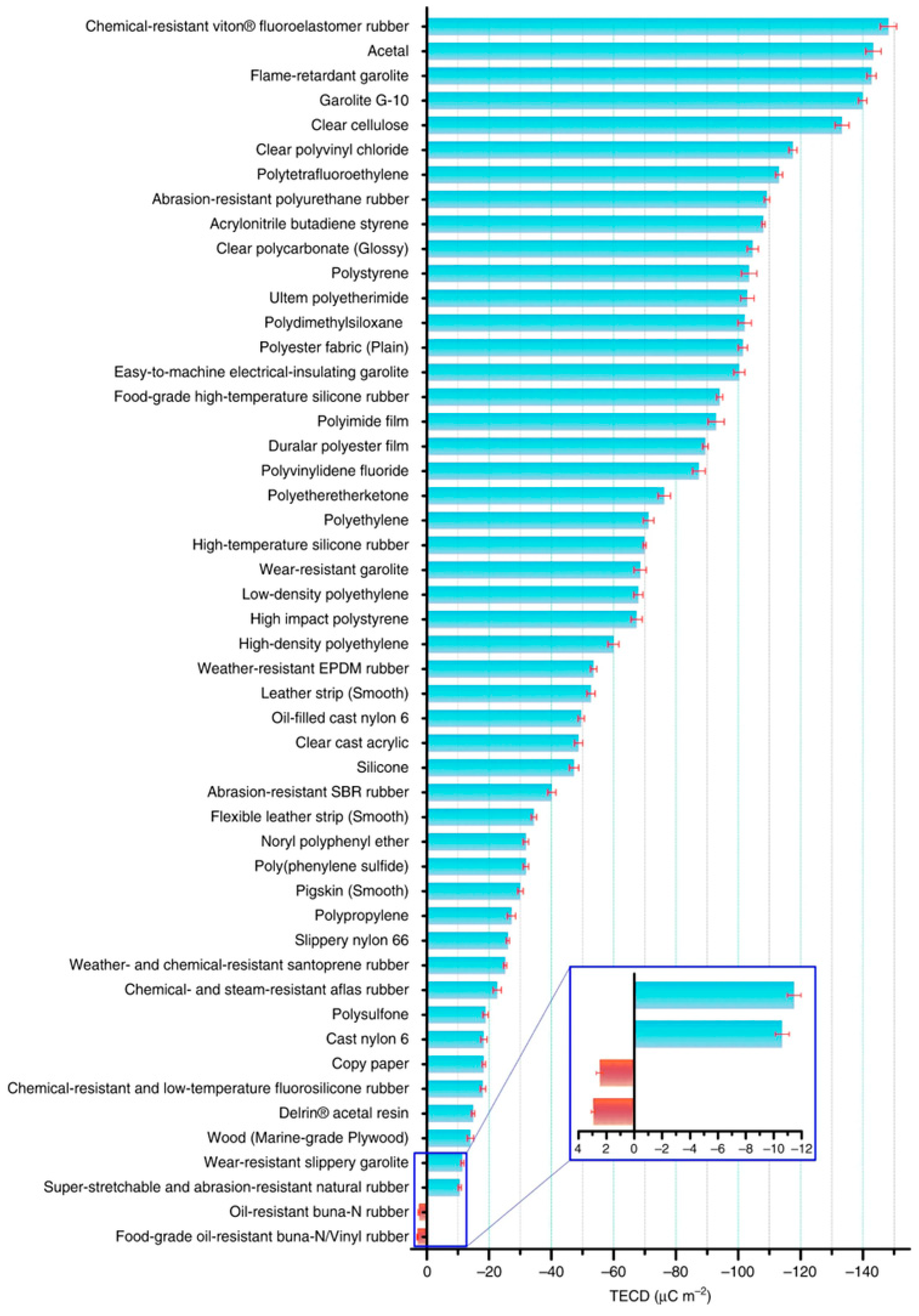
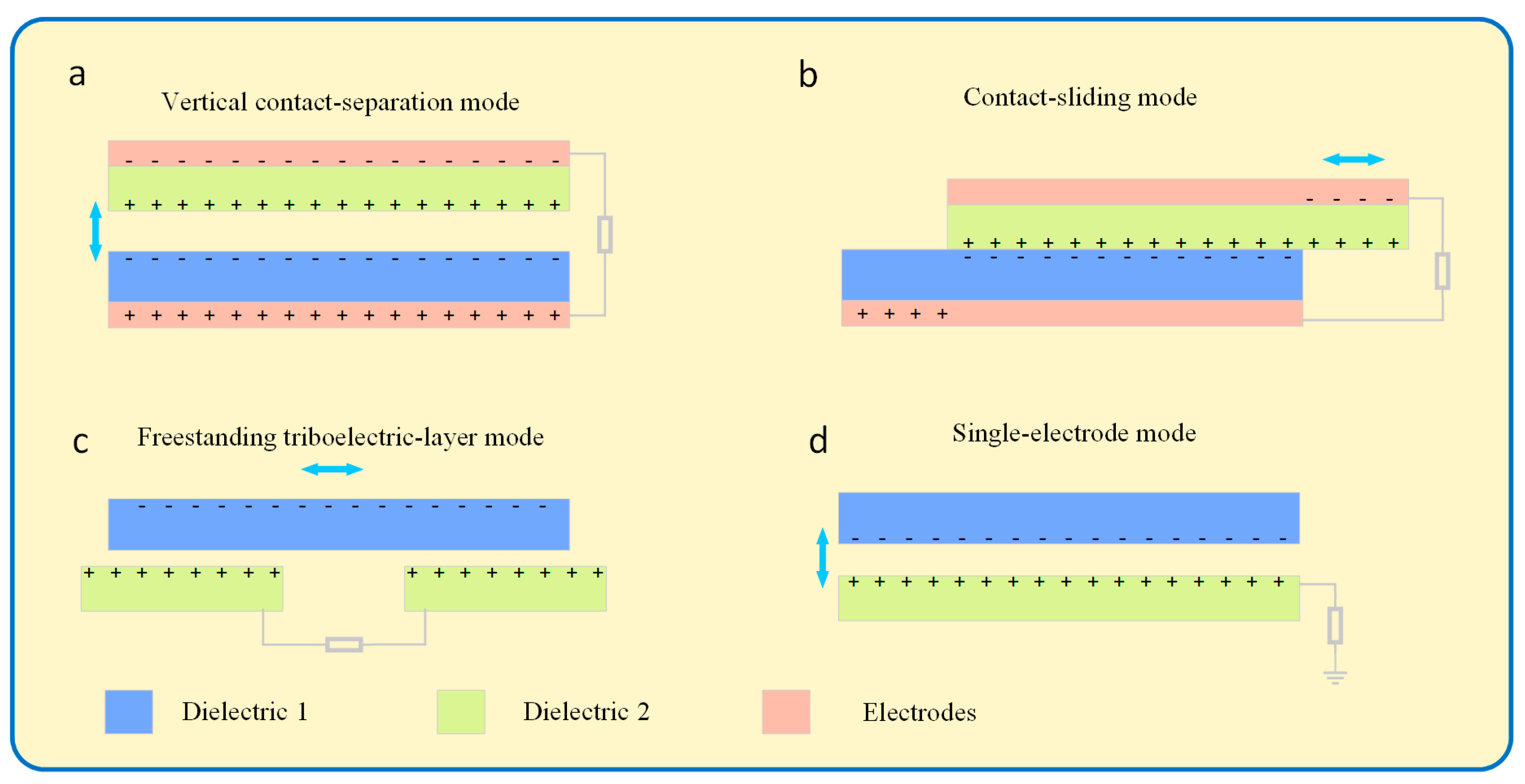
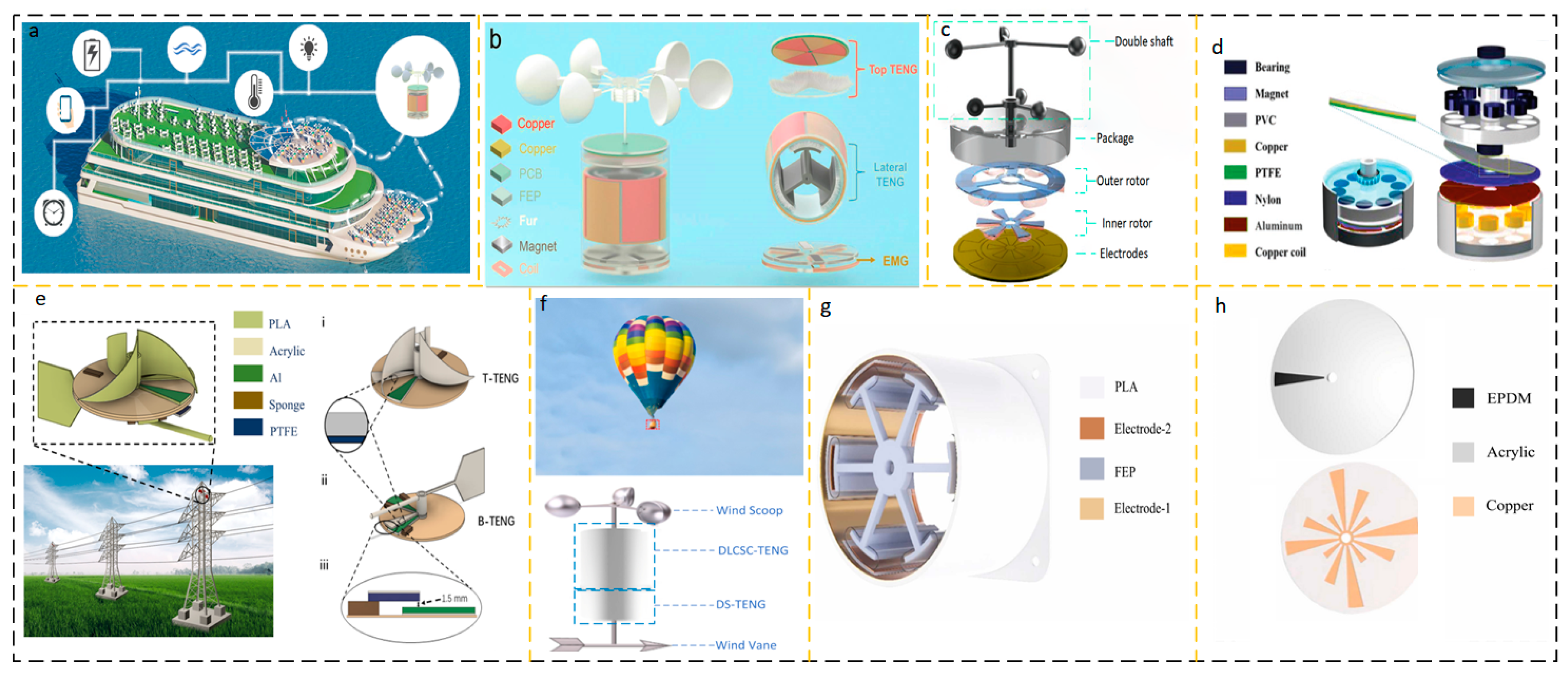
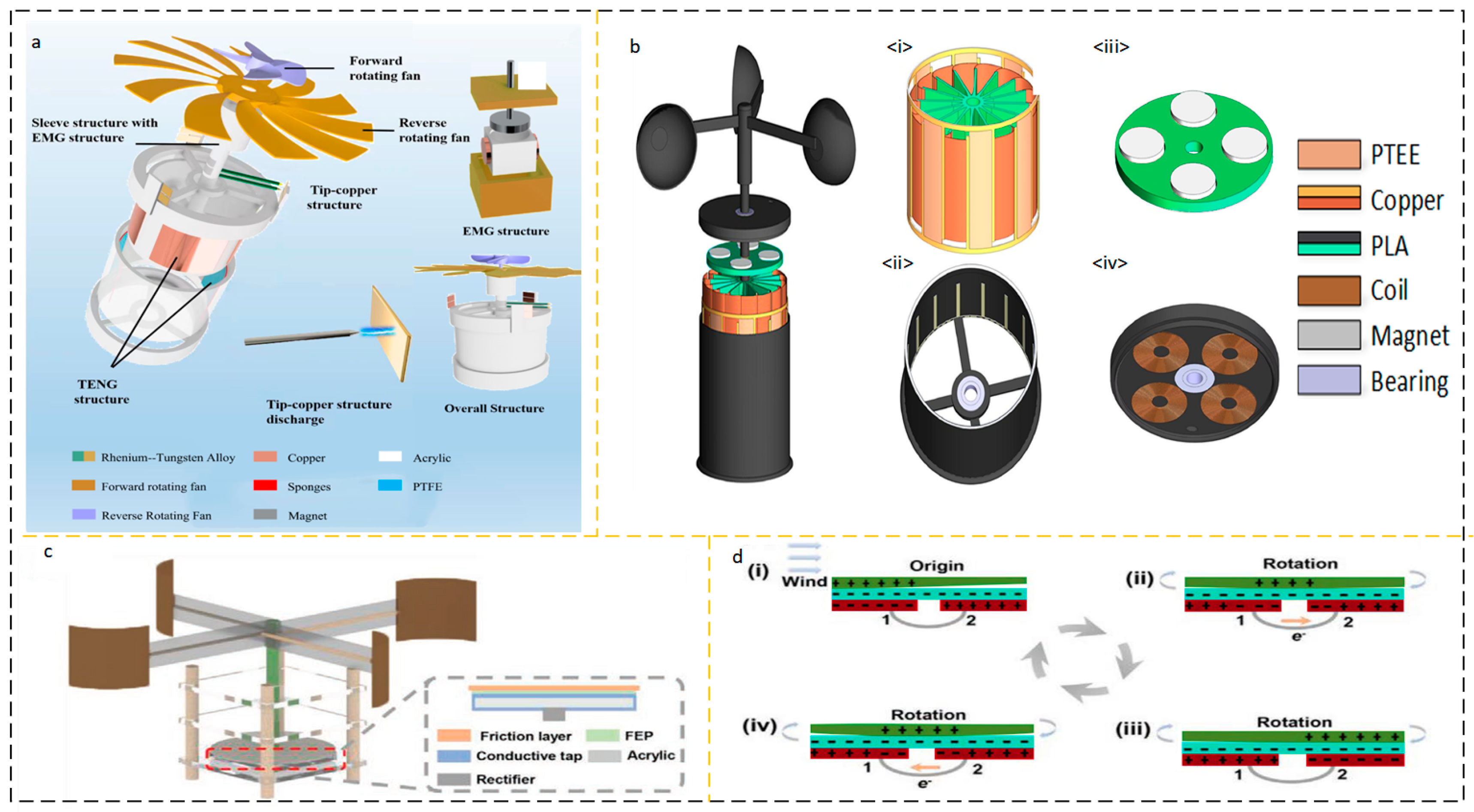
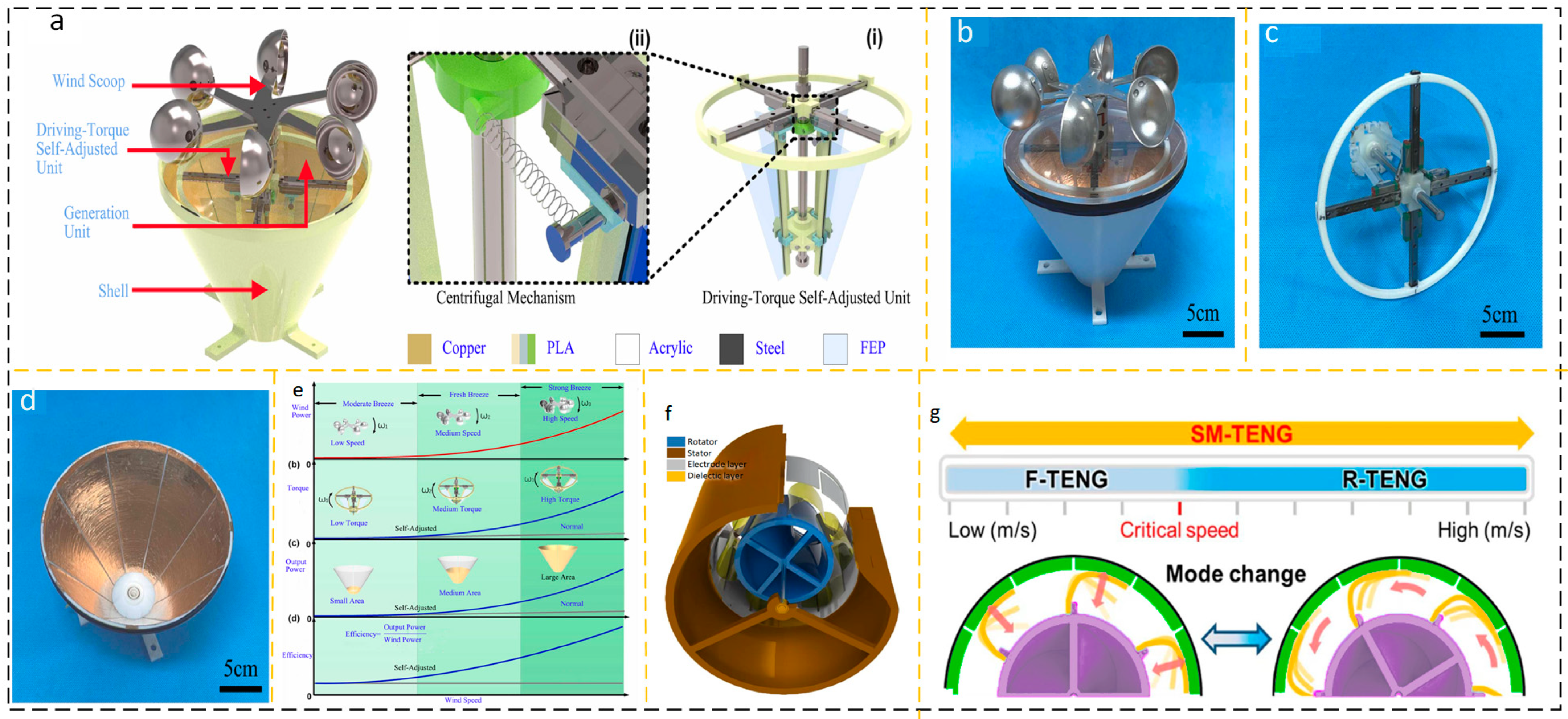
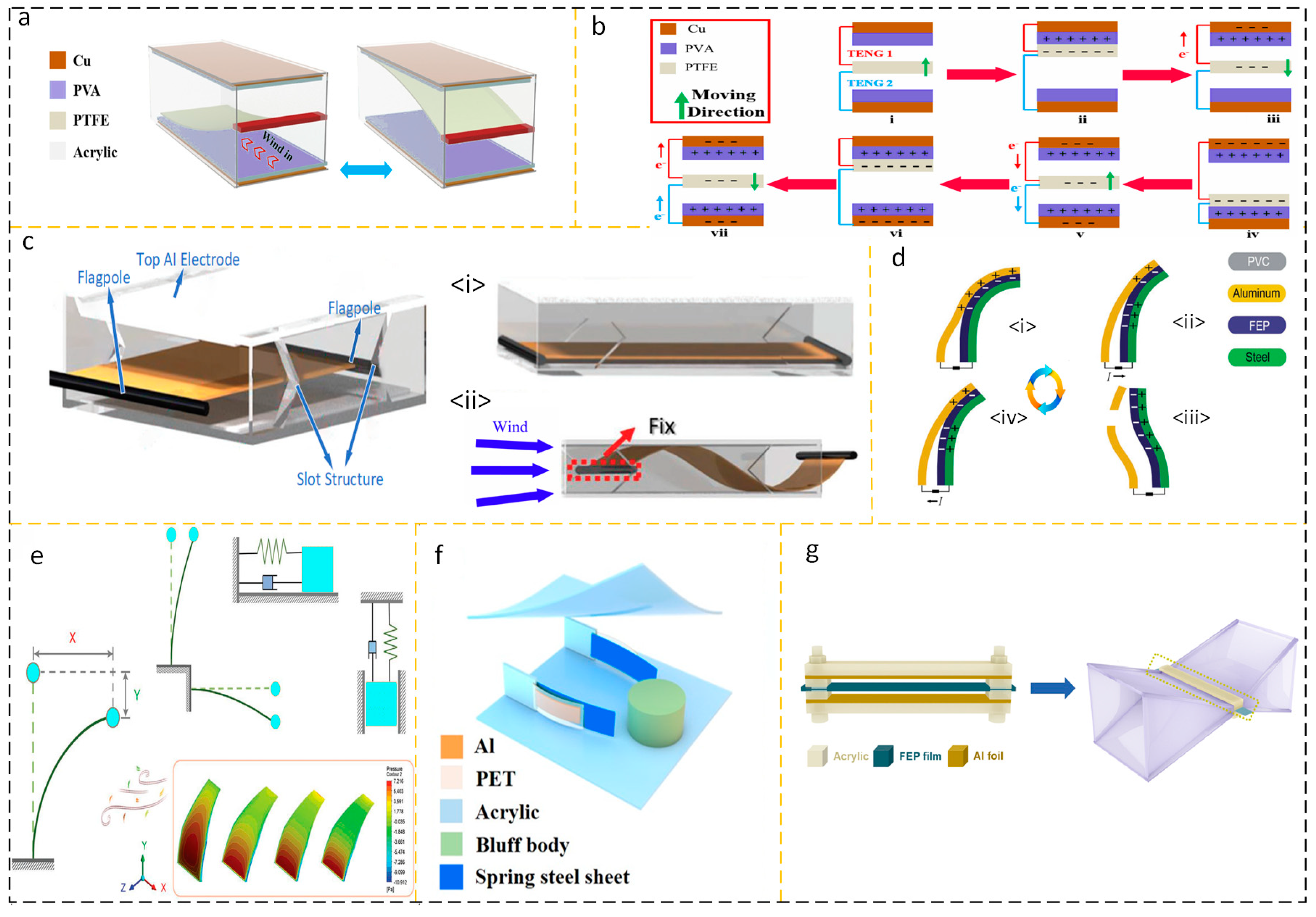
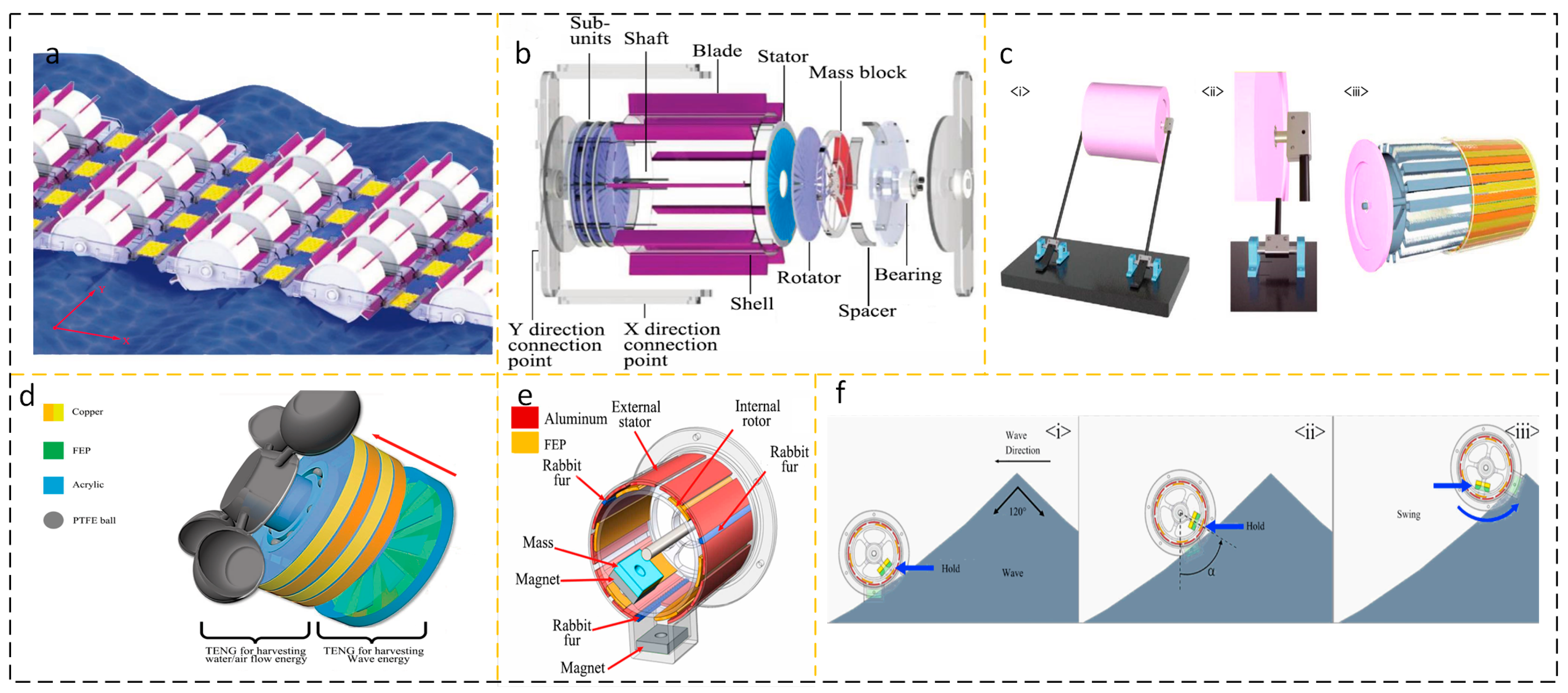

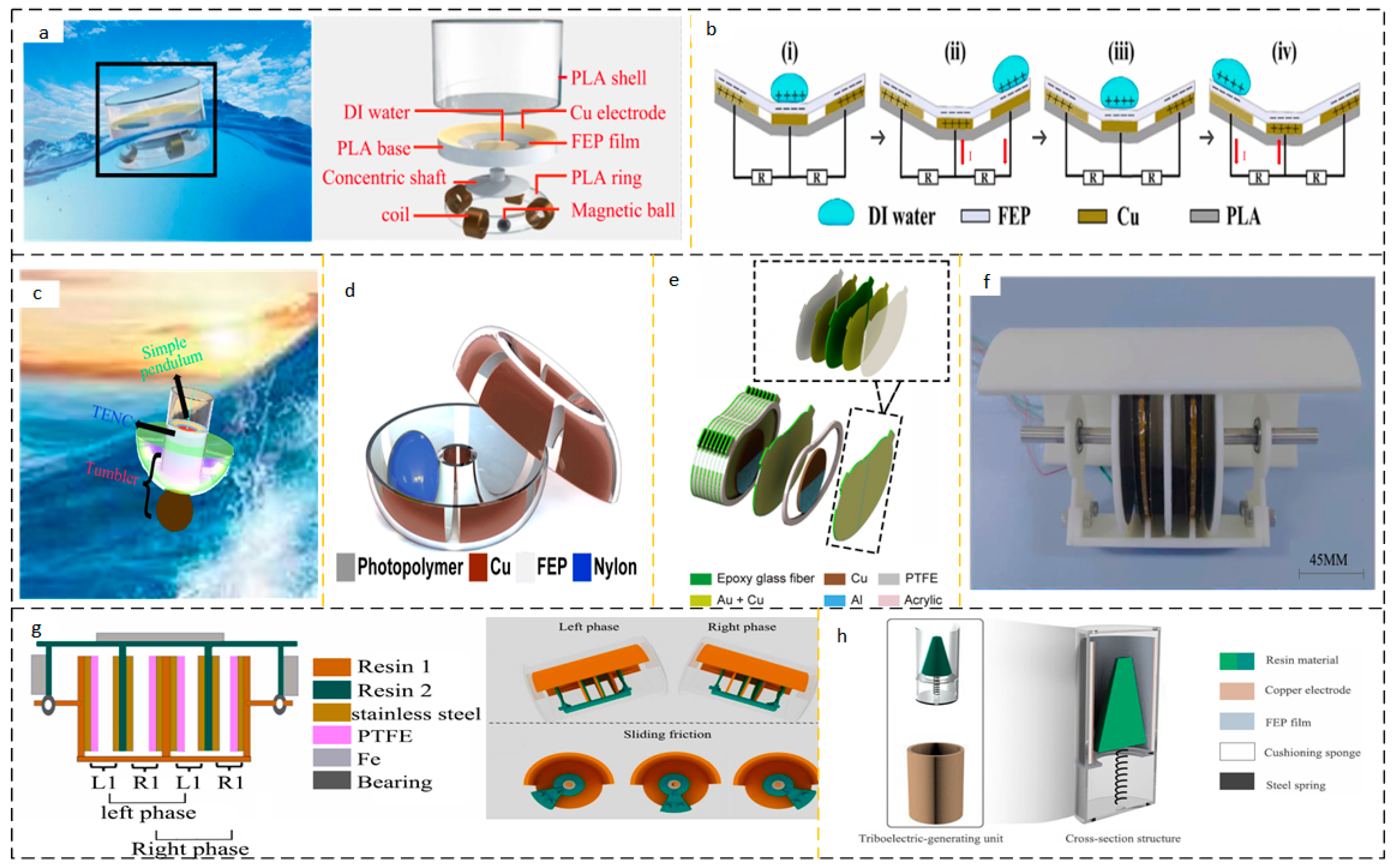


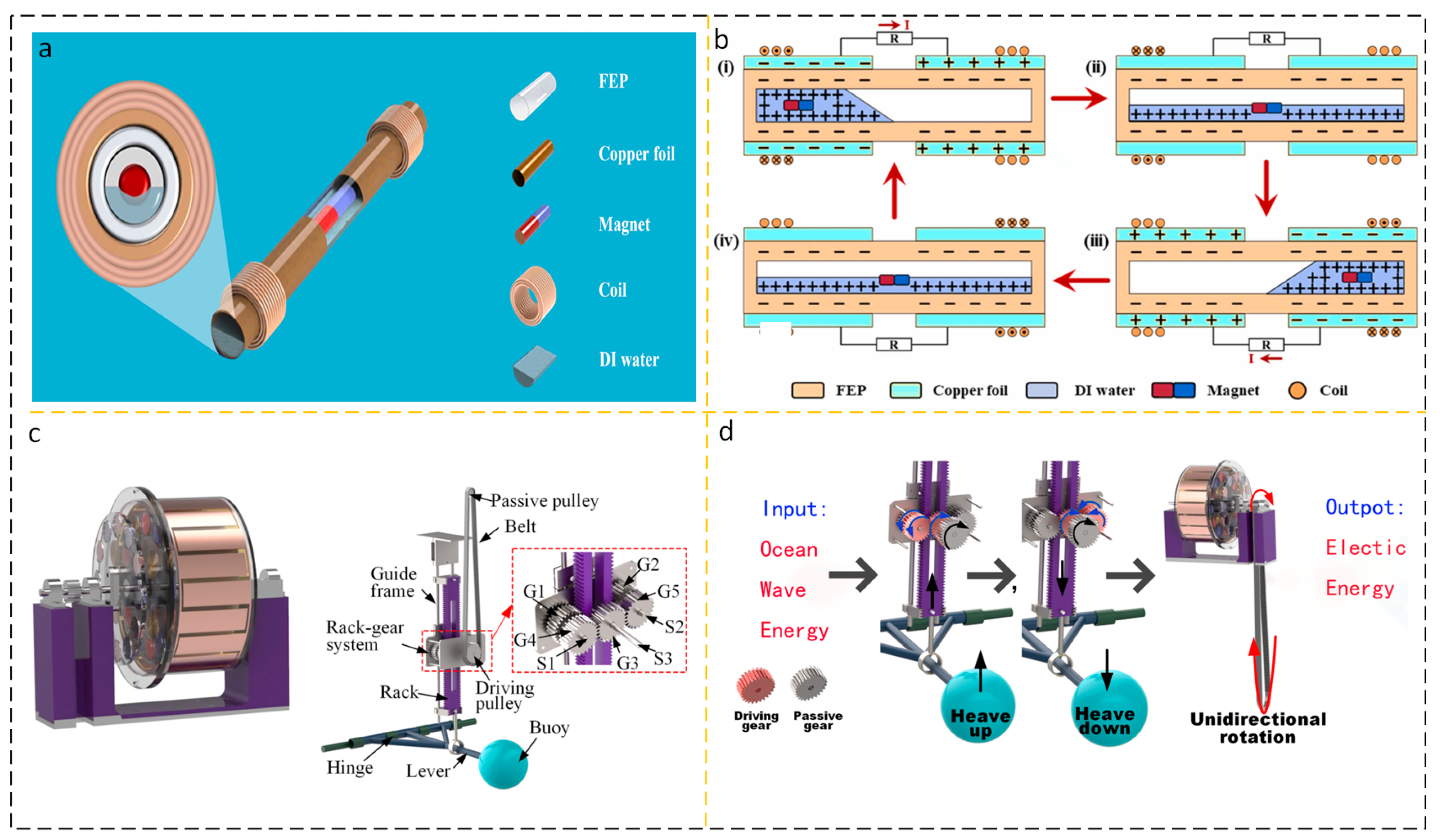
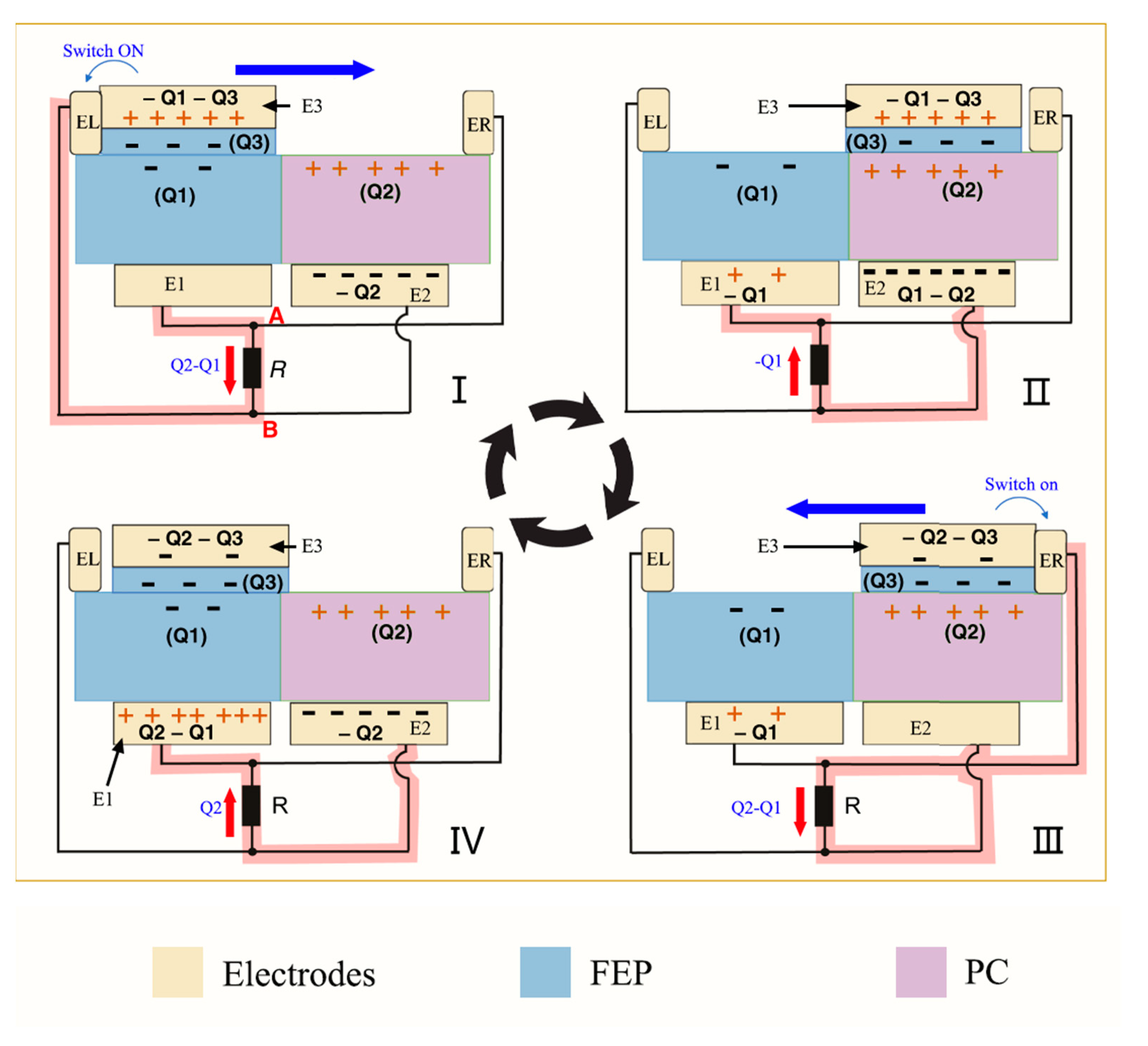
| TENG | Operating Wind Speed Range | Short-Circuit Current | Open-Circuit Voltage | Power | Ref. |
|---|---|---|---|---|---|
| RS-HG | [31] | ||||
| D-TENG | 2.2~16 | [32] | |||
| Hybrid generator | [33] | ||||
| WM-TENG | 168 | None | [34] | ||
| MM-TENG | [35] |
| TENG | Operating Wind Speed Range | Short-Circuit Current | Open-Circuit Voltage | Power/Power Density | Ref. |
|---|---|---|---|---|---|
| TENG-EMG | [36] | ||||
| WH-EH | [37] | ||||
| WNG | [38] |
| TENG | Operating Wind Speed Range | Short-Circuit Current | Open-Circuit Voltage | Power/Power Density | Ref. |
|---|---|---|---|---|---|
| SA-TENG | [39] | ||||
| SM-TENG | [40] |
| TENG | Operating Frequency | Short-Circuit Current | Open-Circuit Voltage | Power/Power Density | Ref. |
|---|---|---|---|---|---|
| WS-TENG | [60] | ||||
| WLM-TENG | [61] | ||||
| multifunctional TENG | [62] | ||||
| FMC-TENG | [63] |
| TENG | Operating Frequency | Short-Circuit Current | Open-Circuit Voltage | Power | Ref. |
|---|---|---|---|---|---|
| EC-TENG | [64] | ||||
| TENG | [65] |
Disclaimer/Publisher’s Note: The statements, opinions and data contained in all publications are solely those of the individual author(s) and contributor(s) and not of MDPI and/or the editor(s). MDPI and/or the editor(s) disclaim responsibility for any injury to people or property resulting from any ideas, methods, instructions or products referred to in the content. |
© 2023 by the authors. Licensee MDPI, Basel, Switzerland. This article is an open access article distributed under the terms and conditions of the Creative Commons Attribution (CC BY) license (https://creativecommons.org/licenses/by/4.0/).
Share and Cite
Yan, J.; Sheng, Y.; Zhang, D.; Tang, Z. Research Progress in Fluid Energy Collection Based on Friction Nanogenerators. Micromachines 2024, 15, 40. https://doi.org/10.3390/mi15010040
Yan J, Sheng Y, Zhang D, Tang Z. Research Progress in Fluid Energy Collection Based on Friction Nanogenerators. Micromachines. 2024; 15(1):40. https://doi.org/10.3390/mi15010040
Chicago/Turabian StyleYan, Jin, Yuxuan Sheng, Dapeng Zhang, and Zhi Tang. 2024. "Research Progress in Fluid Energy Collection Based on Friction Nanogenerators" Micromachines 15, no. 1: 40. https://doi.org/10.3390/mi15010040
APA StyleYan, J., Sheng, Y., Zhang, D., & Tang, Z. (2024). Research Progress in Fluid Energy Collection Based on Friction Nanogenerators. Micromachines, 15(1), 40. https://doi.org/10.3390/mi15010040





